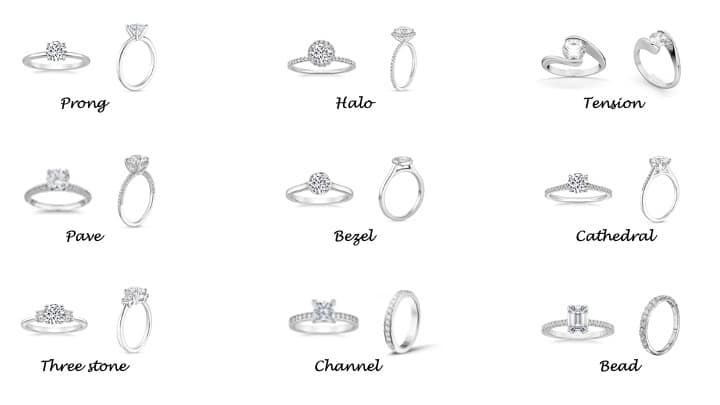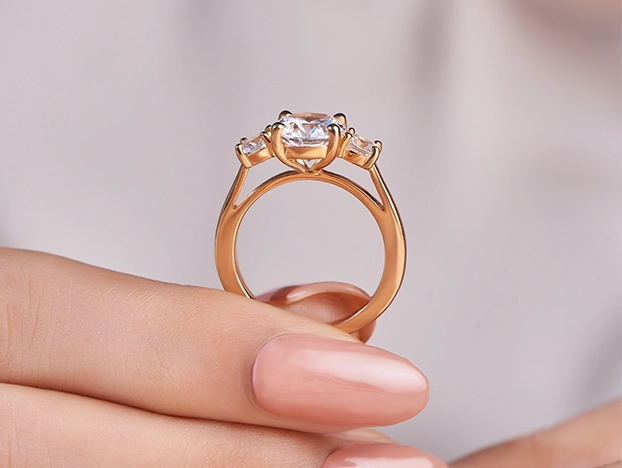See This Report on Engagement Rings
See This Report on Engagement Rings
Blog Article
The Ultimate Guide To Engagement Rings
Table of ContentsEngagement Rings for BeginnersHow Engagement Rings can Save You Time, Stress, and Money.Engagement Rings Things To Know Before You Get ThisSome Known Questions About Engagement Rings.Get This Report on Engagement RingsThe Ultimate Guide To Engagement Rings
Tension-style settings likewise provide much far better safety and security for the gemstone. Many tension-style settings are made for rounded dazzling diamonds or various other round gemstones, yet they can be customized to fit several other forms. The setting can likewise be customized to have accent treasures around the centre rock or to allow for a side stone on each side of the centre rock.Creates an optical illusion of the centre gemstone hanging in the air. If it has prongs, they can end up being loose with wear. This is quickly remedied by having the ring consistently cleansed and checked by a jeweller.
An Unbiased View of Engagement Rings
The initial ring with a true tension setup was made in Vreden, Germany in the 1970s. Ursula Exner and widely known carver Walter Wittek collaborated to design and make this initial ring. In the adhering to years, various other jewelers created their very own tension settings, along with the extra safe and useful tension-style setups.

This provides the ring a simple, yet elegant appeal that functions well for both males and females's wedding celebration rings, along with involvement rings. The flush setup is occasionally additionally called a gypsy setup. We can't state for certain just how it came to have that name, but perhaps it is due to the fact that the setting stands for a totally free spirit.
The Facts About Engagement Rings Uncovered
Flush settings function well for round, square or rectangle-shaped gems, however they can be tough to adapt to particular fancy cuts, for example, a heart-shaped diamond. Maintains the gems safe and safe and secure.
Reminds the owner to cultivate a complimentary spirit (engagement rings). Since the treasures are set in the shank, they obtain a minimal amount of light and create much less luster. Usually unwise for heart-shaped treasures and a couple of other treasures with elegant cuts. Rings with flush or gypsy setups have actually been around considering helpful site that the late 1800s.
Solitaire interaction rings have just one centre gemstone on a plain band. Many various other interaction rings, however, likewise have accent gems.
The 25-Second Trick For Engagement Rings
There are 4 settings that are commonly used to hold accent gems. Castle settings are made directly on the shank of the ring.
The prongs in a castle setting can be right up and down with easy spherical ideas or they can be cut at an angle so that they resemble fishtails. Castle settings are really flexible.
Getting My Engagement Rings To Work
The steel sides of the castle setup are constantly cut low, generally in a scallop pattern. This permits extra light to reach the accent treasures and raises their luster. If it is well made, the reduced scalloped side of the castle setting can likewise create an optical impression. It enables the sides of the gems to be easily seen and produces the impact that the gems are being held in an invisible setup.
Rises light refraction and brilliance. Catches interest with its sparkles. Develops the illusion of an unnoticeable setting. Has a sophisticated beauty. Easy to tidy and calls for little upkeep. The small prongs can become loosened. We recommend that rings with this content the castle setup be cleaned up periodically by a jeweler, to ensure that the prongs can be examined.
The prongs on a castle setting can catch on clothes, however this is unusual due to the fact that the prongs are smooth. The castle setup can be used to make attractive endless time rings.

About Engagement Rings
The bead setting is a very protected setting. One drawback of the bead setup is that the gems receive less light since they are established down in the channel.
Every treasure in the grain setting is bordered by 4 shiny beads that are level with the top of the shank. These beads catch the light and produce their very own glimmers everywhere. The beads' index glimmers with each other with the radiance and shines produced by the accent treasures bring the bead readying to life and provide it constant sparkles.
They can use it to make endless time rings, as well as to enhance the easy shank or even more intricate split shank that some involvement rings have. In the fundamental grain setting, the accent treasures are embeded in one straight line. Sometimes, however, jewelers will enhance the shimmer on an involvement ring by adding 2 or even more parallel lines of bead set treasures.
Report this page